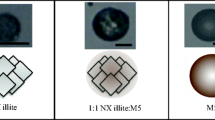Dust events are commonly observed every year and have been shown to strongly impact on the tropospheric ozone budget. This impact arises from the uptake of different gases, such as NOy (mainly as HNO3 or N2O5), on the solid surfaces exhibited by the uplifted minerals. While such “dark” processes have been deeply studied over the last years, dust particles contain a series of oxides that may be initiate photochemical process that have not been considered so far. In fact, in addition to quartz, illite, montmorillonite, and calcite, mineral dusts are heterogeneous mixtures of mineral oxides containing small levels of TiO2. In order to mimic the properties that these oxides confer to mineral Saharan dust, TiO2 and SiO2 were mixed and their heterogeneous reactions with NO2 studied using a horizontal wall flow tube. In addition, experiments were performed with real Arizona test dust in order to assess the importance of photochemical reactions under realistic atmospheric conditions. The effect of light (in the 380-700 nm range), temperature (in the 288-303 K range) and relative humidity have been determined. The uptake coefficient on TiO2 mixing in SiO2 increases with temperature and decreases with relative humidity. We found that despite its very low abundance, titanium dioxide (TiO2) will strongly favour the photo-conversion of NO2 on mineral dust, nitrogen dioxide being otherwise quite unreactive on these minerals. This photoenhanced uptake of gases will in turn impact on the ozone and/or HOx budget during a dust event. In addition, such photo enhanced process will affect the nitrate content of the dust particles, impacting on the optical properties of the aerosols and their associated climatic impact. We therefore exemplified, on mineral dust, that photochemical conversion on solid surfaces encountered in the troposphere needs to be considered an important process of wide impact due to the ubiquitous presence of minerals in our environment as it will change the level of photo-oxidant and aerosol optical properties.
Access this chapter
Tax calculation will be finalised at checkout
Purchases are for personal use only
Preview
Unable to display preview. Download preview PDF.
Similar content being viewed by others
Author information
Authors and Affiliations
Editor information
Editors and Affiliations
Rights and permissions
Copyright information
© 2007 Springer
About this paper
Cite this paper
George, C., Ndour, M., Balkanski, Y., Ka, O. (2007). Photoenhanced Uptake of NO2 on Mineral Dust. In: Mellouki, A., Ravishankara, A.R. (eds) Regional Climate Variability and its Impacts in The Mediterranean Area. NATO Science Series: IV: Earth and Environmental Sciences, vol 79. Springer, Dordrecht. https://doi.org/10.1007/978-1-4020-6429-6_16
Download citation
DOI: https://doi.org/10.1007/978-1-4020-6429-6_16
Publisher Name: Springer, Dordrecht
Print ISBN: 978-1-4020-6427-2
Online ISBN: 978-1-4020-6429-6
eBook Packages: Earth and Environmental ScienceEarth and Environmental Science (R0)




